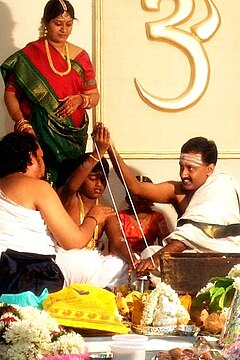Brahmins, Kshatriyas and Vaishyas are called dvijas meaning twice born. A man of these castes is born once in the womb of his mother and again during the Upanayana when he learns the Gayatri Mantra.
The hallmark of having gone through the Upanayana ceremony is the wearing of the Yajñopavītam (Sacred Thread) on the body. The thread is circular, being tied end-to-end (only one knot is permissible); it is normally supported on the left shoulder(savya) and wrapped around the body, falling underneath the right arm. The length of the thread is generally 96 times the breadth of four fingers of a man, which is believed to be equal to his height. Each of the four fingers represents one of the four states that the soul of a man experiences: waking, dreaming, dreamless sleep and knowledge of the absolute.
Yajñopavītam has three threads (actually only one thread, folded three times and tied together) each consisting of three strands. These threads represent
- Goddess Gayatri (Goddess of mind),
- Goddess Saraswati (Goddess of word) and
- Goddess Sāvitrī (Goddess of deed).
It denotes that one who wear the sacred thread should be pure in his thought, word and deed. The sacred thread reminds a Brahmachari to lead a regulated life with purity in his thought, word and deed. These threads also represent the debt that is owed to the guru, parents and society.
The knot in the middle represent the formless Brahman, the pure form of energy which pervades all. The three threads again represent the manifestation of Brahman as Srishti, Sthithi and Vinasa. The sacred thread illustrates the fact that everything in the universe emerge from and then merge with Brahman.
Ancient texts refer to the wearing of the Yajñopavītam in three forms:
- One is Upavītam, where the Yajñopavītam is worn over the left shoulder and under the right arm. This is for Gods. Upavītam is also called savya (Katyayana Shrauta Sutra &c.).
- The Second is Nivītam, where the Yajñopavītam is worn around the neck and over the chest. Nivīta form is to be used during Rishi Tharpana, sexual intercourse, answering the calls of nature etc. (-Shadvimsha Brahmana, Latyayana, etc.).
- The third, Prachīnavītam is where the Yajñopavītam is worn above the right shoulder and under the left arm. This is for Spirits and is used by men when performing the death ceremonies of an elder. Prachīnavītam is also called apsavya (Katyayana Shrauta Sutra, Manusmriti, &c.).
In some communities, later, at the occasion of wedding, a further three threads are added to make for a 6-thread bunch. In some communities, the custom exists of one thread more being added at the birth of every child. In some interpretations, these threads are intended to constantly remind the man of his worldly responsibilities. 3 original threads (each consisting of 3) make up 9 threads, to which 3 are added for wife and 1 for children, making a total of 13 individual threads in some communities.
Ancient Hindu texts specify an age for the Upanayana ceremony based on the caste (7 for Brahmins, 11 for Kshathriyas etc.) Upanayanam marks the start of learning of "Brahman" and Vedic texts. The age for Upanayanam supports this as Brahmins devote their life in pursuing the knowledge of "Brahman" and hence makes sense to start early and continue for a longer time. Kshathriyas on the other hand study additional skills and only go through "Brahman 101". In the communities where three threads are added at the time of wedding, there is another interpretation.
Once a student achieves a certain level of Brahma knowledge ("Brahma Vidya"), the guru adds 3 more strings signifying "Graduation" and the student goes on to study. In South Indian wedding ceremony, the addition of the 3 more string is followed by "Kashi Yatra". This signifies the Yatra student intends for advanced study. At this point, the father of the bride, convinces the youth to get married and then go to Kashi(Varanasi) with his new bride. In modern days, the entire ceremony is packaged within the wedding ceremony.
The sacred thread is supposed to be worn for the rest of one's life after the ceremony has been performed. A new thread is worn and the old thread discarded every year; the change-over ceremony is held on a specific date calculated as per the Hindu lunar calendar. Among Brahmins, this date varies depending on which of four Vedic Shakhas one belongs to.
The sacred thread has close and essential connection with the concept of pravaras related to brahmin gotra system, which reflects the number of most excellent Vedic rishis belonging to that particular gotra to which the wearer of sacred thread belongs. Generally, there are either three or five pravaras. While tying the knots of sacred thread, an oath is taken in the name of these excellent sages. The full affiliation of a Vedic brāhamana consists of (1) gotra, (2)sutra (of Kalpa), (3) shakha, (4) pravaras. (Example :) A brahmana named 'X' introduces himself as follows: I am 'X', of Shrivatsa gotra, of Āpastamba sutra, of Taittiriya shākha of Yajurveda, of five pravaras named Bhārgava, Chyāvana, Āpnavan, Aurva and Jāmdagnya (This example is based upon the example given by Pattābhirām Shastri in the introduction to Vedārtha-Pārijata, cf. ref.)

No comments:
Post a Comment